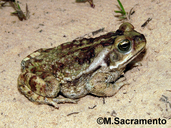|
Rhinella veredas (Brandão, Maciel & Sebben, 2007)
| family: Bufonidae genus: Rhinella |
| Species Description: Brandao, Maciel & Sebben. 2007 A New Species of Chaunus from Central Brazil (Anura; Bufonidae). Journal of Herpetology 41(2): 309-316 | |
 © 2012 Mario Sacramento (1 of 3) |
|
|
|
Description The head is short and narrow with a rounded snout in both dorsal and lateral views. Nostrils are large, with elliptical openings. The tympanum is well developed. Cranial, pretympanic, rostral and supranasal crests are present but weakly developed. Cranial crests are also keratinized, and have more pigment on the thicker parts. The supraocular crest is interrupted anteriorly (in contrast to the continuous supraocular crest seen in B. rubescens). The postocular crest is more fully developed, though short, and makes contact with the parotoid gland. Parotoid glands are distinct and shaped like a narrow, elongated ellipsoid, with small keratinized spicules. Eyelids also sometimes have small keratinized spicules. Vomerine teeth are lacking. Short robust arms bear hands with short, robust, unwebbed fingers. Although fingers are not webbed, they have slightly developed fringes and the tips are keratinized and pigmented. The first finger is longer than the second, and the relative finger length decreases from 3>1>4>2. Males have nuptial pads on fingers I and II. On the feet, toes are weakly webbed, with dark keratinized tips and a relative toe length decreasing from 4>3>5>2>1. The outer metatarsal tubercle is small and round, while the inner metatarsal tubercle is more elongated and somewhat keratinized. A metatarsal fold is present. The dorsal skin is rough due to numerous rounded glands bearing black, pointed, keratinized spiculae. Glands are less numerous and are smaller on the anterior and posterior limb surfaces. No tibial gland is present. The dorsolateral and ventral surfaces are separated by a glandular dorsolateral ridge that runs from the parotoid gland to the groin. The venter itself is smooth. In life Bufo veredas shows clear sexual dimorphism in color between males and females. Most males have a bright yellow dorsum (with some having a gray dorsum), with dark points corresponding to the keratinous spiculae and a white immaculate venter. Females have a complex pattern of brownish (ochre) and green to green-bluish on the dorsum. Males generally have more obvious keratinized spiculae than females. In preservative, male specimens become buff and retain their white venters, while females turn pale brown on the dorsum and grayish elsewhere (Sebben et al. 2007). Newly metamorphosed juveniles exhibit large black and white spots on the chest and belly area, and an orange vent. Tadpoles have not yet been described. Distribution and Habitat Country distribution from AmphibiaWeb's database: Brazil
Life History, Abundance, Activity, and Special Behaviors Comments
References
Brandão, R. A., Maciel, N. M., and Sebben, A. (2007). ''A new species of Chaunus from central Brazil (Anura; Bufonidae).'' Journal of Herpetology, 41, 309-316. Originally submitted by: Henry Zhu (first posted 2008-10-10) Edited by: Kellie Whittaker (2008-11-23) Species Account Citation: AmphibiaWeb 2008 Rhinella veredas <https://amphibiaweb.org/species/6927> University of California, Berkeley, CA, USA. Accessed Apr 20, 2024.
Feedback or comments about this page.
Citation: AmphibiaWeb. 2024. <https://amphibiaweb.org> University of California, Berkeley, CA, USA. Accessed 20 Apr 2024. AmphibiaWeb's policy on data use. |


 Map of Life
Map of Life